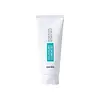What's inside
What's inside
 Key Ingredients
Key Ingredients

 Benefits
Benefits

 Concerns
Concerns

 Ingredients Side-by-side
Ingredients Side-by-side

Water
Skin ConditioningPotassium Cocoyl Glycinate
Acrylates Copolymer
Coco-Betaine
Cleansing1,2-Hexanediol
Skin ConditioningGlycerin
HumectantLactobacillus Ferment
Skin ConditioningSodium Chloride
MaskingPanthenol
Skin ConditioningPyrus Communis Fruit Extract
Skin ConditioningRosa Damascena Flower Water
MaskingIris Florentina Root Extract
MaskingCucumis Melo Fruit Extract
Skin ConditioningHedera Helix Leaf/Stem Extract
AntimicrobialEthylhexylglycerin
Skin ConditioningMoringa Oleifera Leaf Extract
Skin ConditioningSaccharomyces/Xylinum/Black Tea Ferment
Skin ConditioningBackhousia Citriodora Leaf Extract
AstringentDisodium EDTA
Propanediol
SolventButylene Glycol
HumectantLactobacillus Ferment Lysate
Skin ConditioningBakuchiol
AntimicrobialPropolis Extract
Skin ConditioningTaraxacum Officinale Leaf Extract
Skin ConditioningHyaluronic Acid
HumectantSodium Hyaluronate
HumectantHydrolyzed Hyaluronic Acid
HumectantPolyglutamic Acid
Skin ConditioningWater, Potassium Cocoyl Glycinate, Acrylates Copolymer, Coco-Betaine, 1,2-Hexanediol, Glycerin, Lactobacillus Ferment, Sodium Chloride, Panthenol, Pyrus Communis Fruit Extract, Rosa Damascena Flower Water, Iris Florentina Root Extract, Cucumis Melo Fruit Extract, Hedera Helix Leaf/Stem Extract, Ethylhexylglycerin, Moringa Oleifera Leaf Extract, Saccharomyces/Xylinum/Black Tea Ferment, Backhousia Citriodora Leaf Extract, Disodium EDTA, Propanediol, Butylene Glycol, Lactobacillus Ferment Lysate, Bakuchiol, Propolis Extract, Taraxacum Officinale Leaf Extract, Hyaluronic Acid, Sodium Hyaluronate, Hydrolyzed Hyaluronic Acid, Polyglutamic Acid
Water
Skin ConditioningGlycerin
HumectantSodium Cocoyl Alaninate
Hydroxypropyl Methylcellulose
Emulsion Stabilising1,2-Hexanediol
Skin ConditioningSorbitol
HumectantCitric Acid
BufferingHydroxyethylcellulose
Emulsion StabilisingCentella Asiatica Extract 0.098%
CleansingDisodium EDTA
Ethylhexylglycerin
Skin ConditioningSuccinic Acid
BufferingCamellia Sinensis Leaf Extract
AntimicrobialBambusa Vulgaris Water
Skin ConditioningPrunus Armeniaca Fruit Extract
Skin ConditioningButylene Glycol
HumectantWater, Glycerin, Sodium Cocoyl Alaninate, Hydroxypropyl Methylcellulose, 1,2-Hexanediol, Sorbitol, Citric Acid, Hydroxyethylcellulose, Centella Asiatica Extract 0.098%, Disodium EDTA, Ethylhexylglycerin, Succinic Acid, Camellia Sinensis Leaf Extract, Bambusa Vulgaris Water, Prunus Armeniaca Fruit Extract, Butylene Glycol
 Reviews
Reviews

Ingredients Explained
These ingredients are found in both products.
Ingredients higher up in an ingredient list are typically present in a larger amount.
1,2-Hexanediol is a synthetic liquid and another multi-functional powerhouse.
It is a:
- Humectant, drawing moisture into the skin
- Emollient, helping to soften skin
- Solvent, dispersing and stabilizing formulas
- Preservative booster, enhancing the antimicrobial activity of other preservatives
Butylene Glycol (or BG) is used within cosmetic products for a few different reasons:
Overall, Butylene Glycol is a safe and well-rounded ingredient that works well with other ingredients.
Though this ingredient works well with most skin types, some people with sensitive skin may experience a reaction such as allergic rashes, closed comedones, or itchiness.
Learn more about Butylene GlycolDisodium EDTA plays a role in making products more stable by aiding other preservatives.
It is a chelating agent, meaning it neutralizes metal ions that may be found in a product.
Disodium EDTA is a salt of edetic acid and is found to be safe in cosmetic ingredients.
Learn more about Disodium EDTAEthylhexylglycerin (we can't pronounce this either) is commonly used as a preservative and skin softener. It is derived from glyceryl.
You might see Ethylhexylglycerin often paired with other preservatives such as phenoxyethanol. Ethylhexylglycerin has been found to increase the effectiveness of these other preservatives.
Glycerin is already naturally found in your skin. It helps moisturize and protect your skin.
A study from 2016 found glycerin to be more effective as a humectant than AHAs and hyaluronic acid.
As a humectant, it helps the skin stay hydrated by pulling moisture to your skin. The low molecular weight of glycerin allows it to pull moisture into the deeper layers of your skin.
Hydrated skin improves your skin barrier; Your skin barrier helps protect against irritants and bacteria.
Glycerin has also been found to have antimicrobial and antiviral properties. Due to these properties, glycerin is often used in wound and burn treatments.
In cosmetics, glycerin is usually derived from plants such as soybean or palm. However, it can also be sourced from animals, such as tallow or animal fat.
This ingredient is organic, colorless, odorless, and non-toxic.
Glycerin is the name for this ingredient in American English. British English uses Glycerol/Glycerine.
Learn more about GlycerinWater. It's the most common cosmetic ingredient of all. You'll usually see it at the top of ingredient lists, meaning that it makes up the largest part of the product.
So why is it so popular? Water most often acts as a solvent - this means that it helps dissolve other ingredients into the formulation.
You'll also recognize water as that liquid we all need to stay alive. If you see this, drink a glass of water. Stay hydrated!
Learn more about Water